Mechanical Properties of Nano SiO2 and Carbon Fiber Reinforced Concrete after Exposure to High Temperatures
Abstract
:1. Introduction
2. Experimental Program
2.1. Materials and Mixture Proportions
2.2. Preparation of Concretes
2.3. Testing of Concretes
3. Results and Discussion
3.1. Mechanical Properties at Room Temperature
3.1.1. Compressive Strength
3.1.2. Splitting Tensile Strength
3.1.3. Flexural Strength
3.1.4. Microstructure of NSCFRC
3.2. Residual Compressive Strength
3.3. Residual Tensile Strength
3.4. Residual Flexural Strength
3.5. Mechanism of Mechanical Properties of NSCFRC after High Temperature
4. Conclusions
- NSCFRC provided relatively good mechanical properties than PC. The compressive strength, tensile strength and flexural strength of NSCFRC with 0.25% carbon fiber and 1% NS were 6.8%, 20.3% and 11.7% higher than that of PC, respectively.
- The existence of NS can comprehensively improve the mechanical properties of concrete. The compressive strength, tensile strength and flexural strength of S2 (0.15% CFs and 1% NS) were 10%, 6.7%, and 6.4% higher than that of S0 (0.15% CFs without NS), respectively, since it reduces the internal porosity and increases the compactness of the concrete matrix. NS can react with C-H in cement to form C-S-H, which reduces the internal porosity and increases the matrix compactness.
- Similar to previous reports, carbon fiber substantially decreased the compressive strength of CFRC because it increased the internal porosity and reduced the compactness of the concrete matrix. However, it can increase the tensile strength and flexural strength of concrete because it reduces the crack growth across the crack surface, thus resulting in failure at a higher load.
- NSCFRC can improve the mechanical properties of concrete after high-temperature. The effect of high temperature on the residual mechanical properties of NSCFRC was less than in PC, but greater than that of steel fiber-reinforced concrete. After 775 °C, the normalized residual compressive strength, residual tensile strength, and residual flexural strength of NSCFRC with 0.25% carbon fiber and 1% NS were 5.2%, 10.9%, and 8.9% higher than those of PC, respectively.
- NS can effectively improve the mechanical properties of concrete after high-temperature. NS can reduce the internal porosity and increase the matrix compactness after high-temperature. The synergistic effect of NS and carbon fiber was the main factor for the improvement of mechanical properties of NSCFRC after high-temperature.
Author Contributions
Funding
Conflicts of Interest
References
- Hu, X.; Guo, Y.; Lv, J.; Mao, J. The Mechanical Properties and Chloride Resistance of Concrete Reinforced with Hybrid Polypropylene and Basalt Fibers. Materials 2019, 12, 2371. [Google Scholar] [CrossRef] [PubMed]
- Li, Q.; Huang, B.; Xu, S.; Zhou, B.; Yu, R.C. Compressive fatigue damage and failure mechanism of fiber reinforced cementitious material with high ductility. Cem. Concr. Res. 2016, 90, 174–183. [Google Scholar] [CrossRef]
- Hambach, M.; Möller, H.; Neumann, T.; Volkmer, D. Portland cement paste with aligned carbon fibers exhibiting exceptionally high flexural strength (>100 MPa). Cem. Concr. Res. 2016, 89, 80–86. [Google Scholar] [CrossRef]
- Li, M.; Yang, Y.; Liu, M.; Guo, X.; Zhou, S. Hybrid effect of calcium carbonate whisker and carbon fiber on the mechanical properties and microstructure of oil well cement. Constr. Build. Mater. 2015, 93, 995–1002. [Google Scholar] [CrossRef]
- Han, B.; Zhang, L.; Zhang, C.; Wang, Y.; Yu, X.; Ou, J. Reinforcement effect and mechanism of carbon fibers to mechanical and electrically conductive properties of cement-based materials. Constr. Build. Mater. 2016, 125, 479–489. [Google Scholar] [CrossRef]
- Pehlivanlı, Z.O.; Uzun, İ.; Yücel, Z.P.; Demir, İ. The effect of different fiber reinforcement on the thermal and mechanical properties of autoclaved aerated concrete. Constr. Build. Mater. 2016, 112, 325–330. [Google Scholar] [CrossRef]
- Kizilkanat, A.B. Experimental evaluation of mechanical properties and fracture behavior of carbon fiber reinforced high strength concrete. Period. Polytech. Civ. Eng. 2016, 60, 289–296. [Google Scholar] [CrossRef]
- Park, P.; El-Tawil, S.; Park, S.Y.; Naaman, A.E. Cracking resistance of fiber reinforced asphalt concrete at −20 °C. Constr. Build. Mater. 2015, 81, 47–57. [Google Scholar] [CrossRef]
- Song, W.; Yin, J. Hybrid Effect Evaluation of Steel Fiber and Carbon Fiber on the Performance of the Fiber Reinforced Concrete. Materials 2016, 9, 704. [Google Scholar] [CrossRef]
- Galao, O.; Bañón, L.; Baeza, F.J.; Carmona, J.; Garcés, P. Highly Conductive Carbon Fiber Reinforced Concrete for Icing Prevention and Curing. Materials 2016, 9, 281. [Google Scholar] [CrossRef]
- Ding, Y.; Huang, Y.; Zhang, Y.; Jalali, S.; Aguiar, J. Self-monitoring of freeze–thaw damage using triphasic electric conductive concrete. Constr. Build. Mater. 2015, 101, 440–446. [Google Scholar] [CrossRef]
- Ding, Y.; Han, Z.; Zhang, Y.; Aguiar, J. Concrete with triphasic conductive materials for self-monitoring of cracking development subjected to flexure. Compos. Struct. 2016, 138, 184–191. [Google Scholar] [CrossRef]
- Aydin, A.C. Self compactability of high volume hybrid fiber reinforced concrete. Constr. Build. Mater. 2007, 21, 1149–1154. [Google Scholar] [CrossRef]
- Chalioris, C.E.; Kosmidou, P.M.; Karayannis, C.G. Cyclic Response of Steel Fiber Reinforced Concrete Slender Beams; an Experimental Study. Materials 2019, 12, 1398. [Google Scholar] [CrossRef] [PubMed]
- Jalal, M.; Pouladkhan, A.; Harandi, O.F.; Jafari, D. Comparative study on effects of Class F fly ash, nano silica and silica fume on properties of high performance self compacting concrete. Constr. Build. Mater. 2015, 94, 90–104. [Google Scholar] [CrossRef]
- Nili, M.; Ehsani, A. Investigating the effect of the cement paste and transition zone on strength development of concrete containing nanosilica and silica fume. Mater. Des. 2015, 75, 174–183. [Google Scholar] [CrossRef]
- Li, W.; Huang, Z.; Cao, F.; Sun, Z.; Shah, S.P. Effects of nano-silica and nano-limestone on flowability and mechanical properties of ultra-high-performance concrete matrix. Constr. Build. Mater. 2015, 95, 366–374. [Google Scholar] [CrossRef]
- Heidari, A.; Tavakoli, D. A study of the mechanical properties of ground ceramic powder concrete incorporating nano-SiO2 particles. Constr. Build. Mater. 2013, 38, 255–264. [Google Scholar] [CrossRef]
- Yan, L.; Xing, Y.; Zhang, J.; Li, J. High-temperature mechanical properties and microscopic analysis of nano-silica steel fibre RC. Mag. Concr. Res. 2013, 65, 1472–1479. [Google Scholar] [CrossRef]
- Safiuddin, M.; Yakhlaf, M.; Soudki, K. Key mechanical properties and microstructure of carbon fibre reinforced self-consolidating concrete. Constr. Build. Mater. 2018, 164, 477–488. [Google Scholar] [CrossRef]
- Richardson, A.E. Compressive strength of concrete with polypropylene fibre additions. Struct. Surv. 2006, 24, 138–153. [Google Scholar] [CrossRef]
- Wang, X.F.; Huang, Y.J.; Wu, G.Y.; Fang, C.; Li, D.W.; Han, N.X.; Xing, F. Effect of nano-SiO2 on strength, shrinkage and cracking sensitivity of lightweight aggregate concrete. Constr. Build. Mater. 2018, 175, 115–125. [Google Scholar] [CrossRef]
- Cheng, Y.; Shi, Z. Experimental Study on Nano-SiO2 Improving Concrete Durability of Bridge Deck Pavement in Cold Regions. Adv. Civ. Eng. 2019, 2019, 1–9. [Google Scholar] [CrossRef] [PubMed]
- Zhang, P.; Li, Q.; Chen, Y.; Shi, Y.; Ling, Y.F. Durability of Steel Fiber-Reinforced Concrete Containing SiO2 Nano-Particles. Materials 2019, 12, 2184. [Google Scholar] [CrossRef]
- Nazari, A.; Riahi, S. Microstructural, thermal, physical and mechanical behavior of the self compacting concrete containing SiO2 nanoparticles. Mater. Sci. Eng. A 2010, 527, 7663–7672. [Google Scholar] [CrossRef]
- Nazerigivi, A.; Nejati, H.R.; Ghazvinian, A.; Najigivi, A. Effects of SiO2 nanoparticles dispersion on concrete fracture toughness. Constr. Build. Mater. 2018, 171, 672–679. [Google Scholar] [CrossRef]
- Balapour, M.; Joshaghani, A.; Althoey, F. Nano-SiO2 contribution to mechanical, durability, fresh and microstructural characteristics of concrete: A review. Constr. Build. Mater. 2018, 181, 27–41. [Google Scholar] [CrossRef]
- Chen, P.W.; Chung, D.L. Concrete reinforced with up to 0.2 vol % of short carbon fibres. Composites 1993, 24, 33–52. [Google Scholar] [CrossRef]
- European Committee for Standarisation. Eurocode 2: Design of Concrete Structures—Part 1–2: General Rules—Structural Fire Design; AENOR: Madrid, Spain, 2011. [Google Scholar]
- Varona, F.B.; Baeza, F.J.; Bru, D.; Ivorra, S. Influence of high temperature on the mechanical properties of hybrid fiber reinforced normal and high strength concrete. Constr. Build. Mater. 2018, 159, 73–82. [Google Scholar] [CrossRef]
- Li, H.; Gao, D.Y. Splitting Strength of Hybrid Fiber Reinforced Concrete after Exposure to Elevated Temperatures. Appl. Mech. Mater. 2011, 71, 1695–1702. [Google Scholar] [CrossRef]
- Aslani, F.; Samali, B. High strength polypropylene fibre reinforcement concrete at high temperature. Fire Technol. 2014, 50, 1229–1247. [Google Scholar] [CrossRef]
- Ding, Y.; Azevedo, C.; Aguiar, J.B.; Jalali, S. Study on residual behaviour and flexural toughness of fibre cocktail reinforced self compacting high performance concrete after exposure to high temperature. Constr. Build. Mater. 2012, 26, 21–31. [Google Scholar] [CrossRef] [Green Version]
- Gao, D.; Yan, D.; Li, X. Splitting strength of GGBFS concrete incorporating with steel fiber and polypropylene fiber after exposure to elevated temperatures. Fire Saf. J. 2012, 54, 67–73. [Google Scholar] [CrossRef]
- Aslani, F.; Samali, B. Constitutive relationships for steel fibre reinforced concrete at elevated temperatures. Fire Technol. 2014, 50, 1249–1268. [Google Scholar] [CrossRef]
- Ma, Q.; Guo, R.; Zhao, Z.; Lin, Z.; He, K. Mechanical properties of concrete at high temperature—A review. Constr. Build. Mater. 2015, 93, 371–383. [Google Scholar] [CrossRef]
- Ibrahim, R.K.; Hamid, R.; Taha, M.R. Fire resistance of high-volume fly ash mortars with nanosilica addition. Constr. Build. Mater. 2012, 36, 779–786. [Google Scholar] [CrossRef]
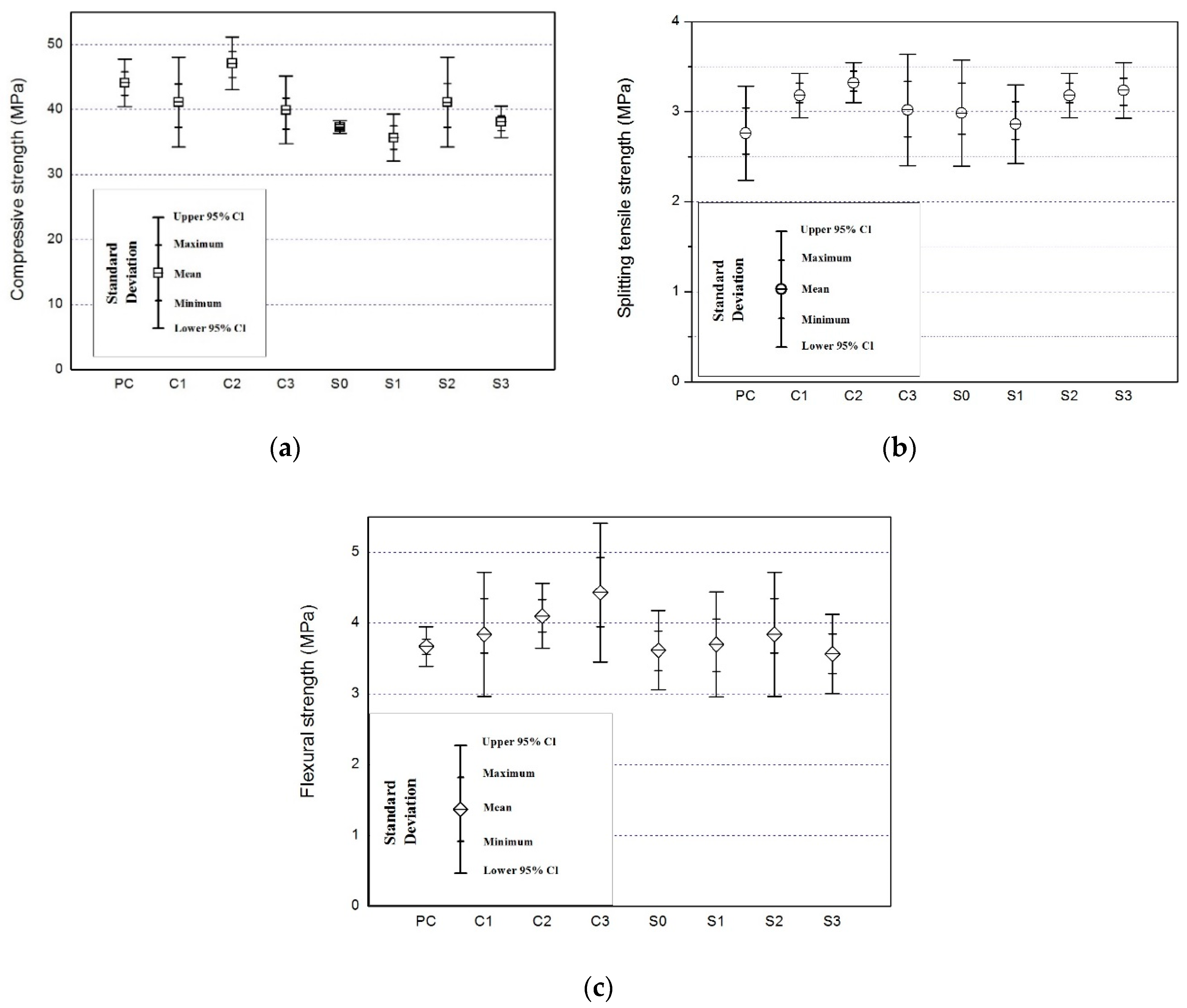
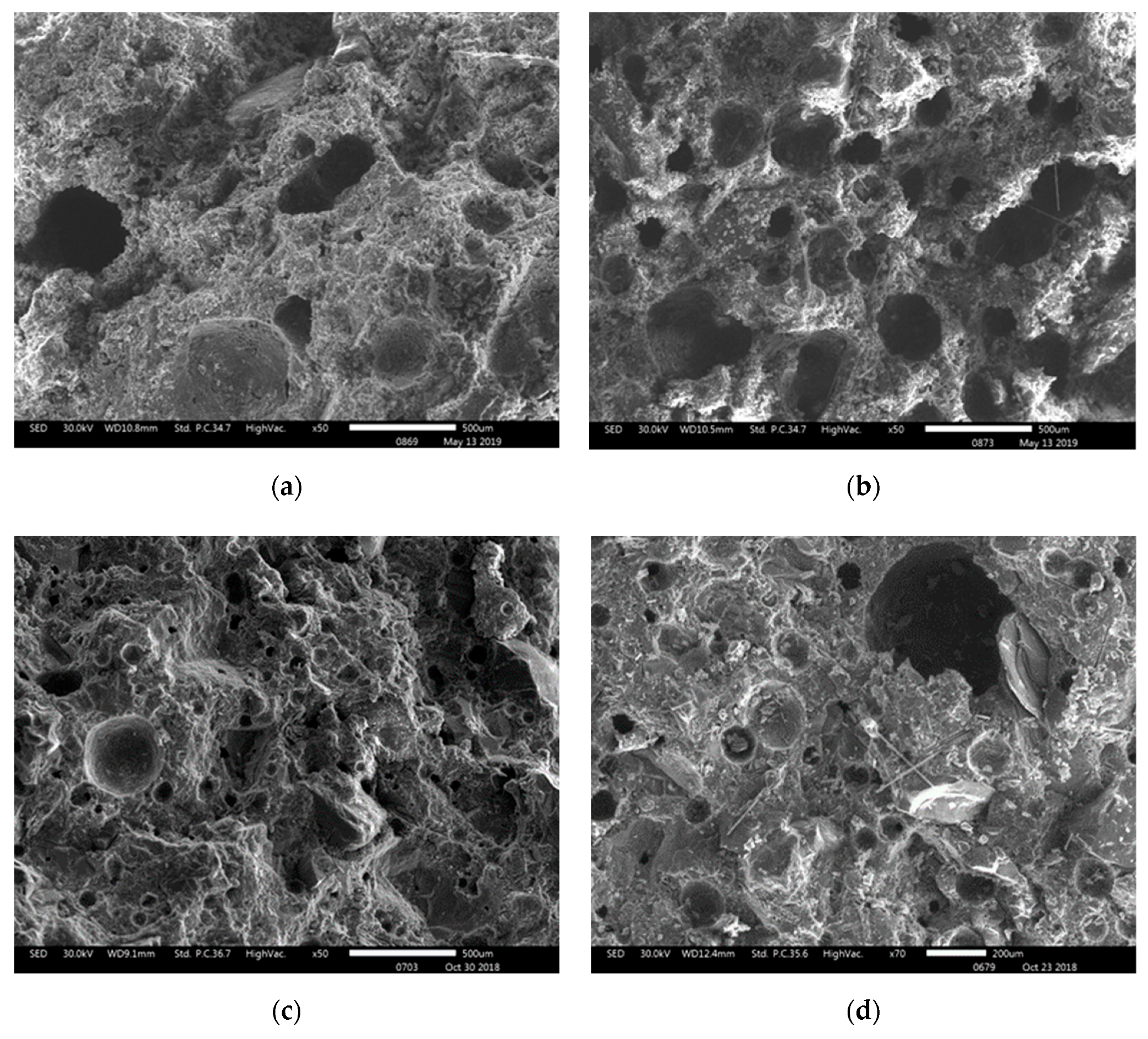
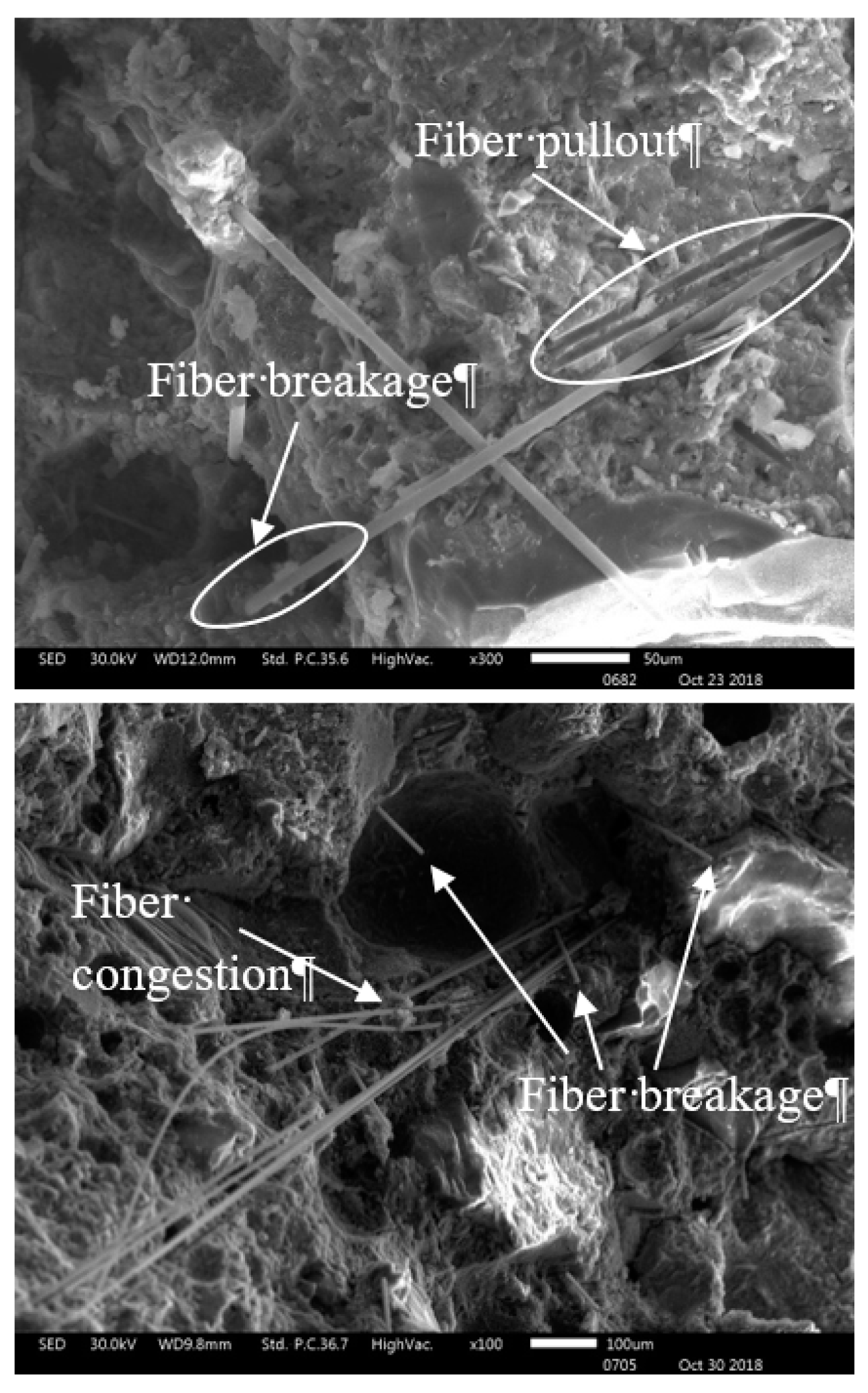
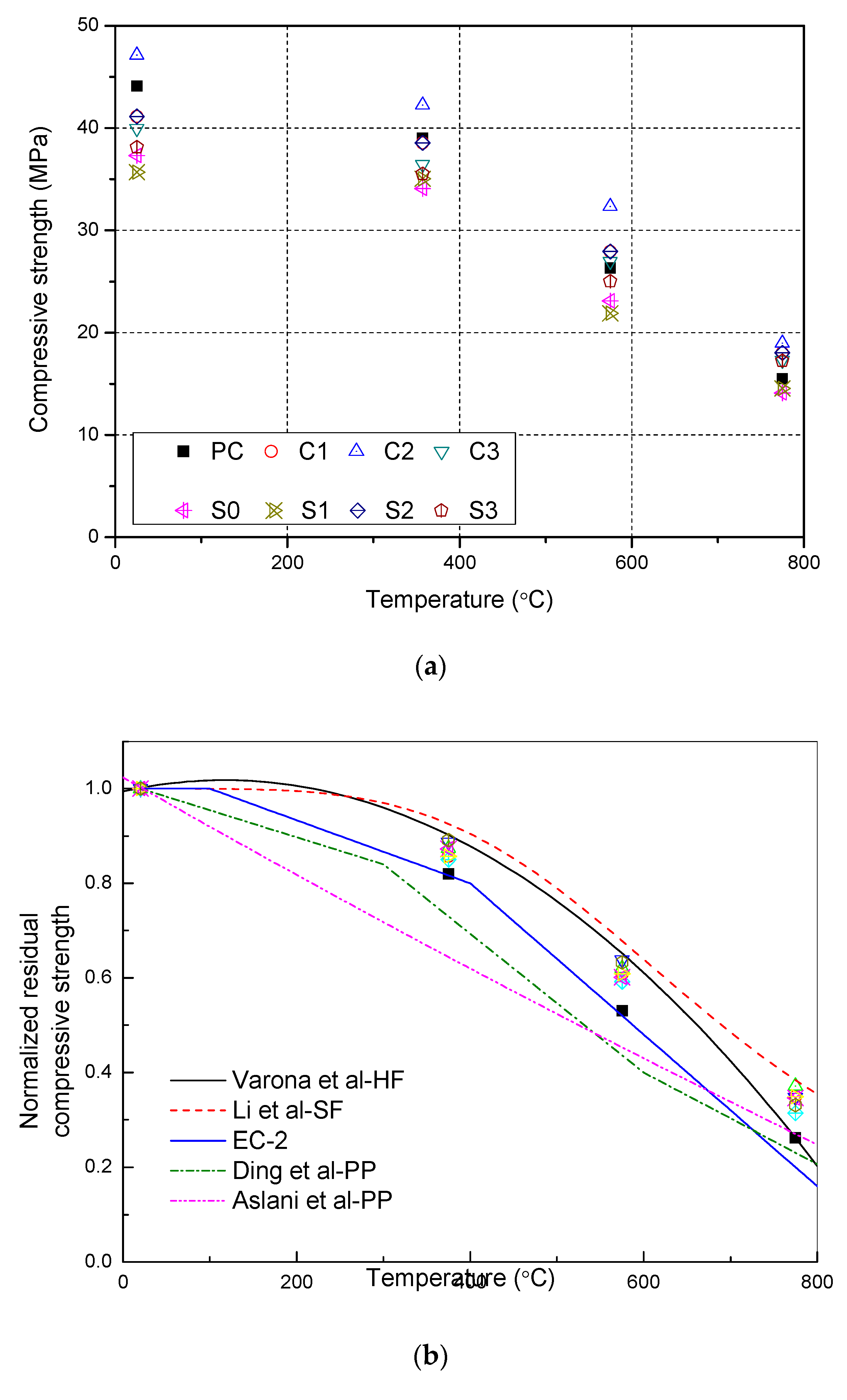
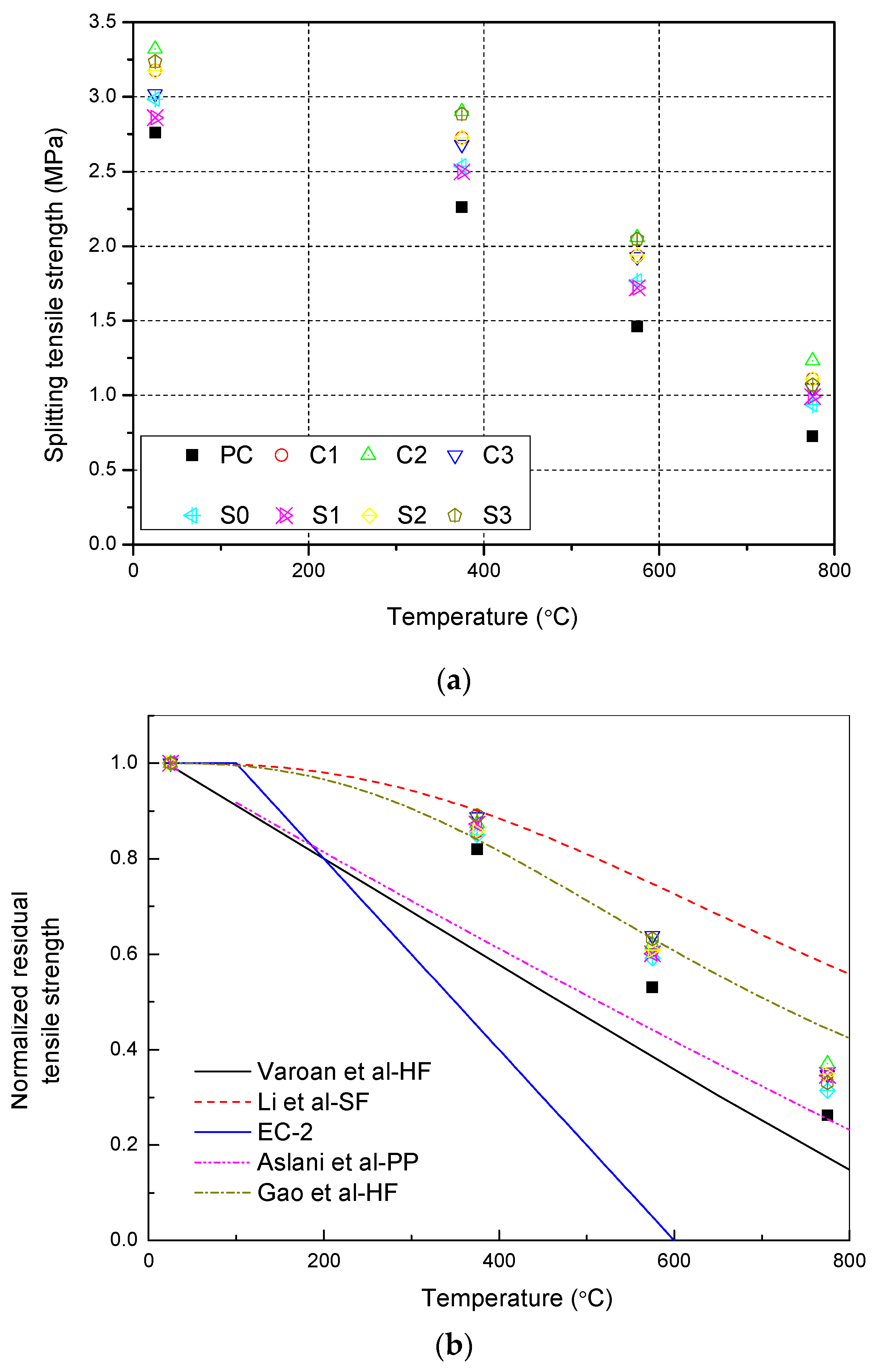

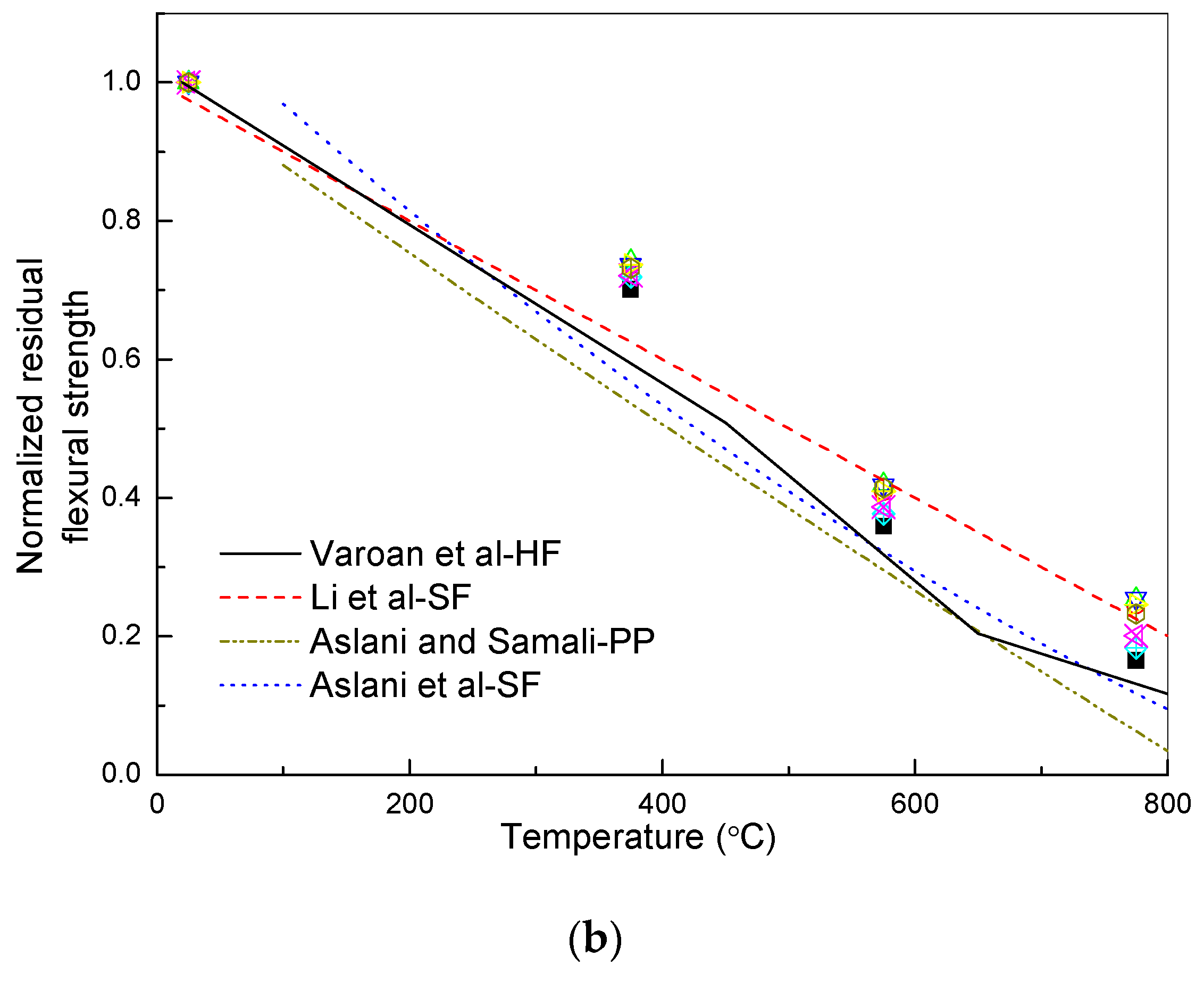
| Material | Properties |
|---|---|
| Carbon fibers | Tensile strength: 3530 MPa Tensile modulus:230 GPa |
| Length: 7 mm Diameter: 7 μm Volume density: 1.76 g/cm3 Carbon content: 93% | |
| Nano-SiO2 | Specific surface area: 380 ± 30 m2/g Mean Particle size: 7 nm |
| Apparent density: ≈ 30 wt.% | |
| Bulk density: ≈ 50 wt.% | |
| SiO2 content: > 99.8% |
| Concrete Mixture | Water/Binder Ratio | Water (kg/m3) | Cement (kg/m3) | FA (kg/m3) | CA (kg/m3) | Nano SiO2 (kg/m3) | CFs (kg/m3) | D (wt.% of Binder) | WR (wt.% of Binder) | DA (wt.% of Binder) |
|---|---|---|---|---|---|---|---|---|---|---|
| PC | 0.45 | 193.5 | 430.0 | 710 | 1075 | 0 | 0 | 0.6 | 1.0 | 0.6 |
| C1 | 0.45 | 193.5 | 425.7 | 710 | 1075 | 4.3 | 2.58 | 0.6 | 1.25 | 0.6 |
| C2 | 0.45 | 193.5 | 425.7 | 710 | 1075 | 4.3 | 4.3 | 0.6 | 1.5 | 0.6 |
| C3 | 0.45 | 193.5 | 425.7 | 710 | 1075 | 4.3 | 6.02 | 0.6 | 1.75 | 0.6 |
| S0 | 0.45 | 193.5 | 430.0 | 710 | 1075 | 0 | 2.58 | 0.6 | 1.0 | 0.6 |
| S1 | 0.45 | 193.5 | 427.9 | 710 | 1075 | 2.1 | 2.58 | 0.6 | 1.25 | 0.6 |
| S2 | 0.45 | 193.5 | 425.7 | 710 | 1075 | 4.3 | 2.58 | 0.6 | 1.25 | 0.6 |
| S3 | 0.45 | 193.5 | 421.4 | 710 | 1075 | 8.6 | 2.58 | 0.6 | 1.25 | 0.6 |
| Concrete Mixture | CFs (vol.% of Concrete) | Nano SiO2 (wt.% of Binder) | Compressive Strength (MPa) | Tensile Strength (MPa) | Flexural Strength (MPa) |
|---|---|---|---|---|---|
| PC | 0 | 0 | 44.1 (4.1%) | 2.76 (9.4%) | 3.67 (3.8%) |
| C1 | 0.15 | 1 | 41.2 (8.4%) | 3.18 (3.9%) | 3.85 (11.4%) |
| C2 | 0.25 | 1 | 47.1 (4.3%) | 3.32 (3.4%) | 4.10 (5.6%) |
| C3 | 0.35 | 1 | 39.9 (6.5%) | 3.02 (10.2%) | 4.43 (11.1%) |
| S0 | 0.15 | 0 | 37.3 (1.3%) | 2.98 (9.9%) | 3.62 (7.8%) |
| S1 | 0.15 | 0.5 | 35.7 (7.2%) | 2.86 (7.6%) | 3.70 (10.0%) |
| S2 | 0.15 | 1 | 41.2 (8.4%) | 3.18 (3.9%) | 3.85 (11.4%) |
| S3 | 0.15 | 2 | 38.1 (3.1%) | 3.24 (4.7%) | 3.57 (7.9%) |
| Concrete Mixture | CFs (vol.% of Concrete) | Nano SiO2 (wt.% of Binder) | 25 °C (MPa) | 375 °C (MPa) | 575 °C (MPa) | 775 °C (MPa) |
|---|---|---|---|---|---|---|
| PC | 0 | 0 | 44.1 (4.1%) | 39.0 (5.4%) | 26.3 (10.4%) | 15.5 (26.6%) |
| C1 | 0.15 | 1 | 41.2 (8.4%) | 38.5 (8.7%) | 27.9 (11.8%) | 18.0 (14.1%) |
| C2 | 0.25 | 1 | 47.1 (4.3%) | 42.3 (6.0%) | 32.3 (16.0%) | 19.0 (14.3%) |
| C3 | 0.35 | 1 | 39.9 (6.5%) | 36.4 (8.9%) | 27.0 (8.1%) | 17.3 (24.0%) |
| S0 | 0.15 | 0 | 37.3 (1.3%) | 34.1 (4.9%) | 23.1 (7.4%) | 14.1 (7.0%) |
| S1 | 0.15 | 0.5 | 35.7 (7.2%) | 35.0 (2.5%) | 21.9 (6.7%) | 14.6 (37.4%) |
| S2 | 0.15 | 1 | 41.2 (8.4%) | 38.5 (8.7%) | 27.9 (11.8%) | 18.0 (14.1%) |
| S3 | 0.15 | 2 | 38.1 (3.1%) | 35.5 (13.3%) | 25.0 (18.2%) | 17.2 (4.0%) |
| Concrete Mixture | CFs (vol.% of Concrete) | Nano SiO2 (wt.% of Binder) | 25 °C (MPa) | 375 °C (MPa) | 575 °C (MPa) | 775 °C (MPa) |
|---|---|---|---|---|---|---|
| PC | 0 | 0 | 2.76 (9.4%) | 2.26 (8.9%) | 1.46 (16.1%) | 0.72 (28.2%) |
| C1 | 0.15 | 1 | 3.18 (3.9%) | 2.73 (4.0%) | 1.94 (5.0%) | 1.11 (18.0%) |
| C2 | 0.25 | 1 | 3.32 (3.4%) | 2.90 (4.6%) | 2.06 (2.3%) | 1.23 (7.9%) |
| C3 | 0.35 | 1 | 3.02 (10.2%) | 2.68 (7.4%) | 1.93 (12.9%) | 1.05 (17.7%) |
| S0 | 0.15 | 0 | 2.98 (9.9%) | 2.54 (5.6%) | 1.77 (10.7%) | 0.94 (15.9%) |
| S1 | 0.15 | 0.5 | 2.86 (7.6%) | 2.50 (5.3%) | 1.72 (27.0%) | 0.99 (13.9%) |
| S2 | 0.15 | 1 | 3.18 (3.9%) | 2.73 (4.0%) | 1.94 (5.0%) | 1.11 (18.0%) |
| S3 | 0.15 | 2 | 3.24 (4.7%) | 2.88 (6.1%) | 2.05 (5.2%) | 1.07 (25.0%) |
| Concrete Mixture | CFs (vol.% of Concrete) | Nano SiO2 (wt.% of Binder) | 25 °C (MPa) | 375 °C (MPa) | 575 °C (MPa) | 775 °C (MPa) |
|---|---|---|---|---|---|---|
| PC | 0 | 0 | 3.67 (3.8%) | 2.58 (6.5%) | 1.32 (18.3%) | 0.61 (7.4%) |
| C1 | 0.15 | 1 | 3.85 (11.4%) | 2.83 (8.6%) | 1.57 (5.2%) | 0.94 (11.8%) |
| C2 | 0.25 | 1 | 4.10 (5.6%) | 3.04 (4.1%) | 1.72 (17.4%) | 1.04 (8.0%) |
| C3 | 0.35 | 1 | 4.43 (11.1%) | 3.26 (5.5%) | 1.86 (8.3%) | 1.13 (12.5%) |
| S0 | 0.15 | 0 | 3.62 (7.8%) | 2.60 (16.8%) | 1.36 (14.5%) | 0.66 (14.5%) |
| S1 | 0.15 | 0.5 | 3.70 (10.0%) | 2.67 (15.4%) | 1.43 (23.4%) | 0.74 (21.2%) |
| S2 | 0.15 | 1 | 3.85 (11.4%) | 2.83 (8.6%) | 1.57 (5.2%) | 0.94 (11.8%) |
| S3 | 0.15 | 2 | 3.57 (7.9%) | 2.61 (17.7%) | 1.48 (9.8%) | 0.83 (21.8%) |
© 2019 by the authors. Licensee MDPI, Basel, Switzerland. This article is an open access article distributed under the terms and conditions of the Creative Commons Attribution (CC BY) license (http://creativecommons.org/licenses/by/4.0/).
Share and Cite
Wu, L.; Lu, Z.; Zhuang, C.; Chen, Y.; Hu, R. Mechanical Properties of Nano SiO2 and Carbon Fiber Reinforced Concrete after Exposure to High Temperatures. Materials 2019, 12, 3773. https://doi.org/10.3390/ma12223773
Wu L, Lu Z, Zhuang C, Chen Y, Hu R. Mechanical Properties of Nano SiO2 and Carbon Fiber Reinforced Concrete after Exposure to High Temperatures. Materials. 2019; 12(22):3773. https://doi.org/10.3390/ma12223773
Chicago/Turabian StyleWu, Linsong, Zhenhui Lu, Chenglong Zhuang, Yu Chen, and Ruihua Hu. 2019. "Mechanical Properties of Nano SiO2 and Carbon Fiber Reinforced Concrete after Exposure to High Temperatures" Materials 12, no. 22: 3773. https://doi.org/10.3390/ma12223773




